In order to make sure your small business gets discovered online by potential customers, it’s important you understand how to do keyword research.
If you’re not sure about keywords, keyword research or how to use a free keyword research tool, don’t worry!
In this tutorial, we are going to show you how any business of any size can engage in either free or paid keyword research through four easy methods.
Keyword research ultimately helps you identify the right keywords you should be using and adding in your digital marketing activities and throughout your website.
Read more: How to use Google trends.
What are Keywords?
Keywords are popular search terms or search phrases that people type into Google Search (or other search engines such as Bing or Yahoo) with the intention to find specific information online.
Why are Keywords Important?
Keywords are important ranking factors for your website, business, and brand.
Basically, when potential customers type in a keyword associated with your business, products or services, your business will show up on search engines such as Google.
How To Do Keyword Research?
In this keyword research tutorial for beginners, we’re going to show you four easy methods for local businesses to start engaging in keyword research.
In other words, how you can research what types of keywords you should be using for your website and business online?
Keyword research essentially plays an important role in the online growth of your business.
With that said, let’s go ahead and dive into keyword research!
Read more: Learn how to engage in PREMIUM keyword research using Semrush (review + tutorial)
1. Getting Started With Keyword Research
During this how-to-do keyword research tutorial, we’re going to focus on four different keyword research tools to help you with keyword research.
Before we get started, it’s important to note that two of these methods are completely free and the other two are paid methods!
We will identify which are completely free keyword research tools and which are not when discussing each method.
2. Google Search (Keyword Research Method Number 1)

The first free keyword research tool and method that you can use to engage in keyword research is to leverage Google search.
To do this:
- Head over to Google in your browser.
- Type in a keyword in the Google search bar that you think your potential customers are typing into Google to find your business, products, or services.
For the purpose of this tutorial on how to do keyword research, we’re going to use a roofing company that’s based in Sydney as an example throughout this tutorial.
As you can see, the relevant keyword we added is ‘Roof repair Sydney’ (see screengrab).
Once you’ve typed in a keyword:
- Navigate down to ‘Ads’ .
Multiple different ads will appear based on the keyword that you searched for.
- Take a look at each title and description of these ads, and simply identify any keywords that are similar to the keyword that you just typed into the Google search bar.
- Add any relevant keyword search terms for your business down on a ‘Target keyword list’.
- Make sure you do this with every ‘Ad’ on Google to find more similar and relevant keywords.
This list should have about 10-20 relevant keywords.
For example, if we navigate down here the first ad that appears for us is ‘Tiled roof repair’ (see screengrab).
This title is relevant to our business and brand, so we would simply add this to our target keyword list.
We recommend adding these to a Google document, spreadsheet, other note-recording tools, or even just on a piece of paper.
Basically, you want to make sure you identify and write down the keywords that are similar to the keyword that you entered into Google Search.
For us, we’re also going to add ‘House roof repair’ and ‘Roofing supplies’ (see screengrab).
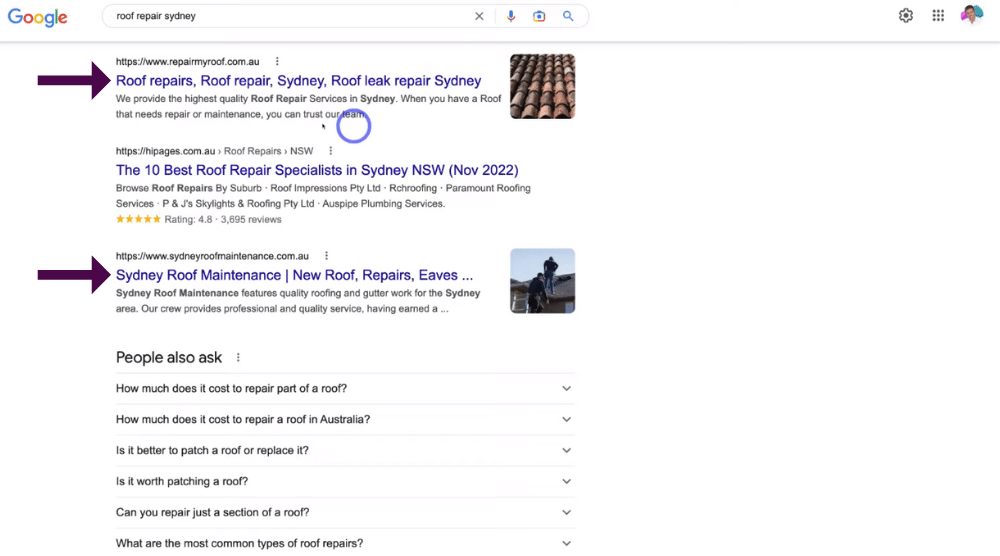
After you’ve added in any keywords from the ads section of your Google search:
- Scroll down past the map listings to find general website results.
- Again identify the keywords in both the title description of these results.
You can read our blog on How to add your local business to Google maps.
In this example, you can see this title has ‘Roof repairs’, ‘Roof repair’, ‘Sydney’ and ‘Roof leak repair Sydney’ that we haven’t added to our target keyword list yet.
Therefore, we’re going to add ‘Roof leak repair Sydney’, ‘Roof repair services’, ‘Sydney roof maintenance’, and ‘New roof’ from the titles and descriptions of these results (see screengrab).
Make sure you take the time to navigate your way through the first page of Google search and identify keywords that are in both the title and the description of websites that are ranking high in Google search.
Again, you want to make sure you are adding 10-20 keywords that you want to target to get you started.
Once you’ve done this with the original keyword that you searched:
- Head back up to your search bar and type in another keyword that you want to do some research on.
- Follow the same simple process.
Essentially, leveraging Google search is one of the best free ways you can easily find keywords that your competitors are ranking for that you also want to use in your online marketing activities (such as adding those keywords in your Google Ad campaigns).
By doing this, you’re able to then use those keywords to rank your website higher in search engines like Google search when a potential customer types in those keywords!
Let’s move on to the second method of how to do keyword research.
Read more: How to connect Google Domain to Google Sites
3. Keywords Everywhere Extension (Keyword Research Method Number 2)
This method leverages Google search again, however through a Google Chrome extension called ‘Keywords Everywhere’, which is a paid keyword research tool.
To get started with this method:
- Head over to your Chrome or Firefox browser.
- Type in keywordseverywhere.com in the search bar.

That’s going to take you here (see screengrab).
- Select ‘Install for Chrome’ or ‘Install for Firefox’ (depending on the browser that you usually use).
For the purpose of this how-to-do keyword research tutorial, we’ve already installed the Keywords Everywhere keyword research tool onto our Chrome browser.
Once you’ve installed the ‘Keywords Everywhere’ extension:
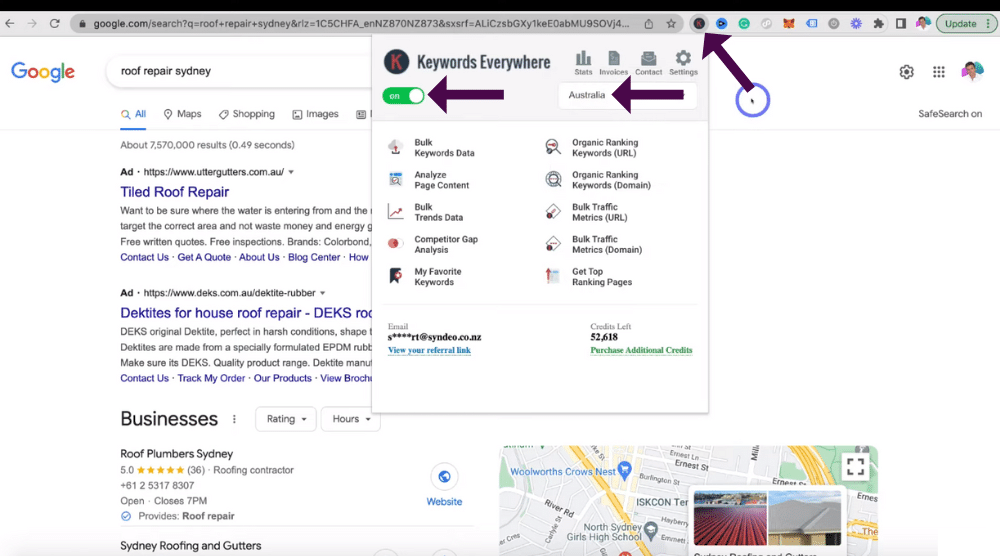
- Head back to Google search.
- Navigate up to ‘Extensions’ and find the Keywords Everywhere research tool extension (see screengrab).
- Click ‘On’ to turn the extension on.
- To the right of this, you’re able to select the country that you want to target.
For us, we’re engaging in keyword research for a roofing company that’s based in Australia, so we’re going to select ‘Australia’.
Think about where your audience is located or what country you want to target and select the country based on that.
Additionally, you have the option to select ‘Global’ if your audience is based all around the world.
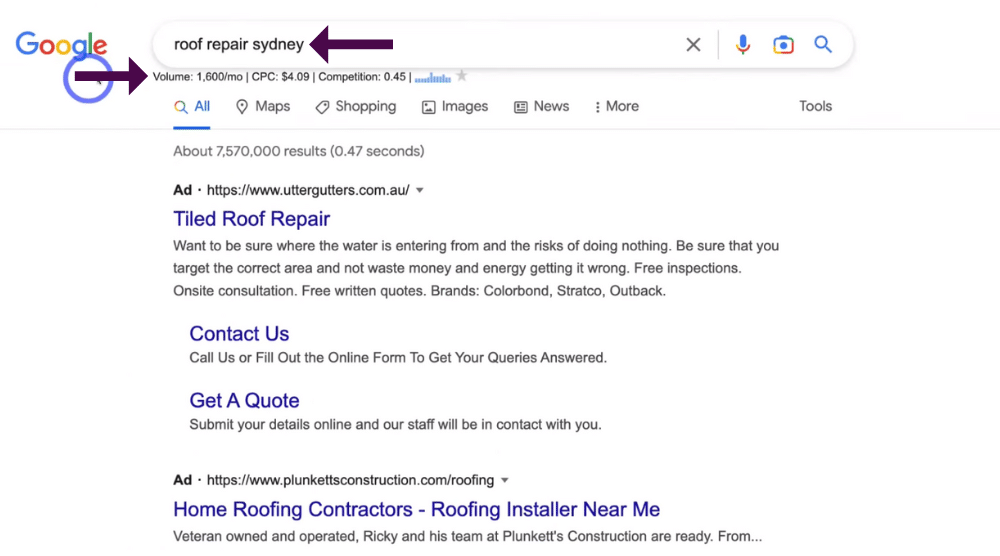
Once you’ve done this:
- Click out of the Keywords Extension.
- Refresh your browser page.
The first thing that you’ll notice once you’ve turned on the Keywords Everywhere extension and refreshed the page is that you now have volume, CPC (cost per click) and competition level below your Google search bar (see screengrab).
This means that now when you type in a keyword search term in your Google search bar that you want to do keyword research on, you’ll be able to see three things:
1. The amount of search volume per month next to ‘Volume’.
So for our example, our keyword search term ‘Roof repair Sydney’ is searched 1600 times per month in Australia.
2. The CPC (cost per click) of your keyword search terms next to CPC.
Our CPC for this keyword search term is $4.09.
What that means is if we were running Google Ads like these ads here (see screengrab), and a potential customer clicks through to our website when they click on one of these ads, we would be paying $4.09 per click.
Again, this is only really useful if you’re using Google Ads to drive your business, meaning if we were targeting this keyword ‘Roof repair Sydney’ with Google Ads, it would cost us $4.09 (the cost per click) if a potential customer collects on our ad.
You read our blog on Google Analytics tutorial for beginners.
3. The competition level, meaning the amount of competition of other competitors trying to rank for this search term.
It’s important to note that 1 is the highest competition.
The competition level for this keyword is 0.45, so therefore this keyword search term is medium competition.
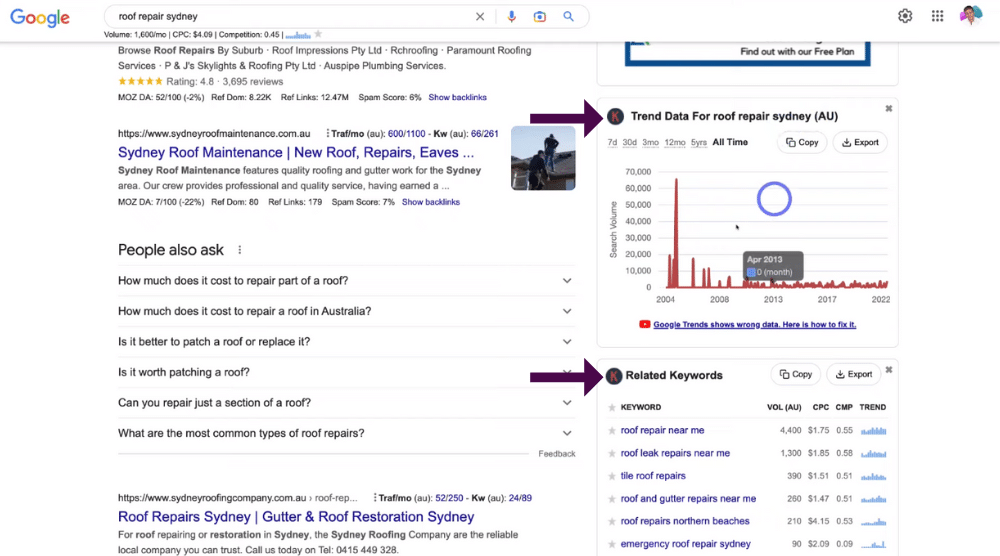
Additionally:
- Scroll down the page to view the trend data for the keyword that you typed in (remember for us this was ‘Roof repair Sydney’) (see screengrab).
- Here you can see the overall growth of that search term, meaning how many times have people searched for that particular keyword over a period of time.
As you can see, the keyword ‘Roof repair Sydney’ has been pretty stable over the last 10 years (see screengrab).
- Below ‘Trend data’, you’ll see ‘Related keywords’.
This is where Keywords Everywhere generates a list of other related keywords that you may want to target.
- Besides each of these keywords, you’re able to also see the search volume, the CPC, competition level and the trend data.
For example, ‘Roof repair near me’ is a popular search term with over 4400 searches per month and a low CPC (see screengrab).
Therefore, this would be a keyword that we would want to add to our target keywords list.
We suggest taking the time to navigate through these other suggested relative keywords and add any of these keywords that you think are relevant to your business, products, or services.
The aim is to identify keywords that have a relatively high search volume and low to medium competition for you to then use. These are good keywords!

- Below ‘Related Keywords’, navigate down below the heading ‘People Also Searched For’ (see screengrab).
This is where you can actually view other popular keywords that people are also searching for on Google search.
- Add some of those keywords to your target keyword list that you want to use for your business.
Remember, your target keyword list should have at least 10-20 keywords.

- Finally, under ‘People also searched for’, you’ll see a list of suggested ‘Long-Tail Keywords’ (see screengrab).
Essentially, Long-tail keywords are longer search terms.
For example, we’re going to add the suggested keywords ‘Leaking roof repair Sydney’ and ‘Roof leak repair Sydney’.
For us, Keywords Everywhere also offers other keyword ideas such as ‘Slate roof repair Sydney’ and ‘Emergency roof repair Sydney’ (if these are services we offer).
Make sure you are only adding keywords that are relevant to your business, so if we didn’t offer ‘Slate roof repairs’, we wouldn’t add this as a keyword search term.
You can also turn off some of these settings if you like now.
It’s important to mention that every time you search for a keyword using the Keywords Everywhere Extension, you’re using credit, and once you’ve run out of all your keyword search credits then you’ll have to pay for more credit.
What is credit?
Think of credits as monetary value every time you search for a keyword.
In other words, one credit equals one keyword, meaning that every time you search for a keyword, you use one credit.
It’s also important to note that your credits do expire after one year.

To buy more credits:
- Head back over to the Keywords Everywhere website.
- Click ‘Pricing’.
- Select ‘Buy now’ to which credit option you want to buy (see screengrab).
For example, if you buy ten dollars worth of credits, that equals 100,000 (and 100,000 search terms).
So as you can see, there is a small investment in this method on how to do keyword research, but it’s worth it if you’re serious about keyword research!
Next, we’re going to move away from Google search for keyword research and look at two separate tools (one is free and one is paid) where you can engage in keyword research.
4. Keyword Planner (Keyword Research Method Number 3)
The first tool that we want to highlight is called the Keyword Planner that can be found within your Google Ads account.
To access this tool:
- Head over to your browser.
- Type in ads.google.com.
It’s important to note that to use this Keyword Planner tool for keyword research, you don’t actually have to spend money on Google Ads.
This means that technically it is a free keyword planner tool!
However, we should mention that if you spend money on Google Ads then you’ll be able to receive more detailed data that you can then measure within the Keyword Planner,
If you currently don’t have a Google Ads account and you’re completely new to Google Ads, check out our Google Ads beginners guide here which will guide you through the process of creating your first ad and setting up your account.
We suggest reading that tutorial first, then simply jumping back into this Google Ads keyword research method.

Once you’ve signed up for free or signed into Google Ads:
- You’ll be taken to your Google Ads dashboard (see screengrab).
- Click the ‘Tools and settings’ heading at the top of the screen.
- Under ‘Planning’ on the left-hand side, select ‘Keyword Planner’.
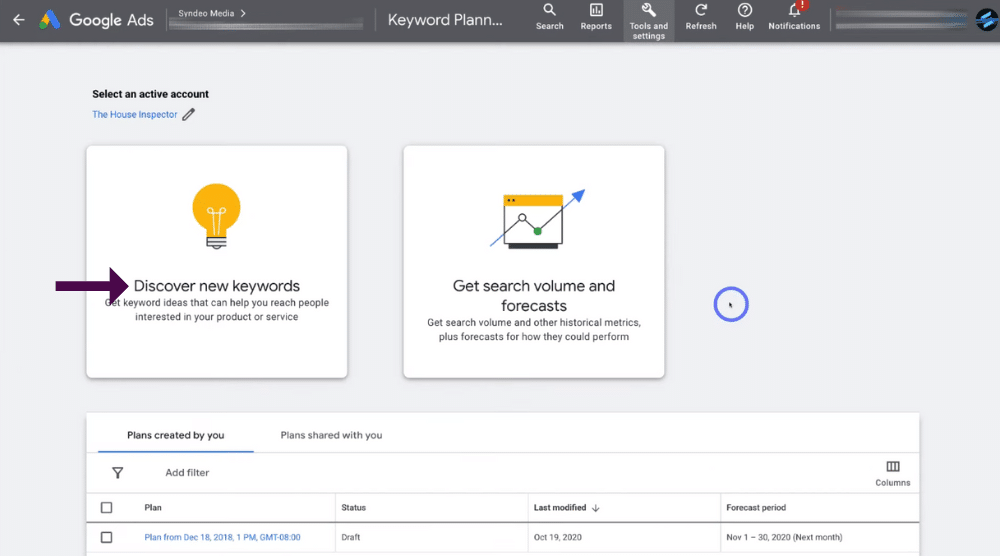
- If you have multiple accounts, you’ll then be asked to select an account.
- Click ‘Discover new keywords’.
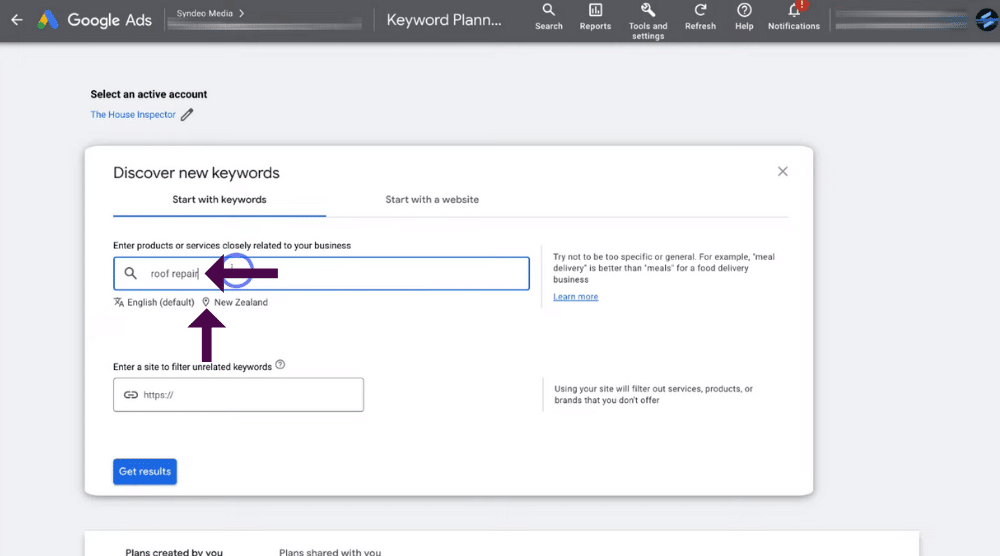
- Under ‘Start with keywords’, add a keyword in the search bar (see screengrab).
We’re going to continue to use the keyword we’ve been using in previous examples of this keyword research tutorial, except we’re going to leave out ‘Sydney’ (see screengrab).
This means our keyword will be ‘Roof repair’.
To change the country (which country you want to target your keyword in):
- Click on the location image below the search bar
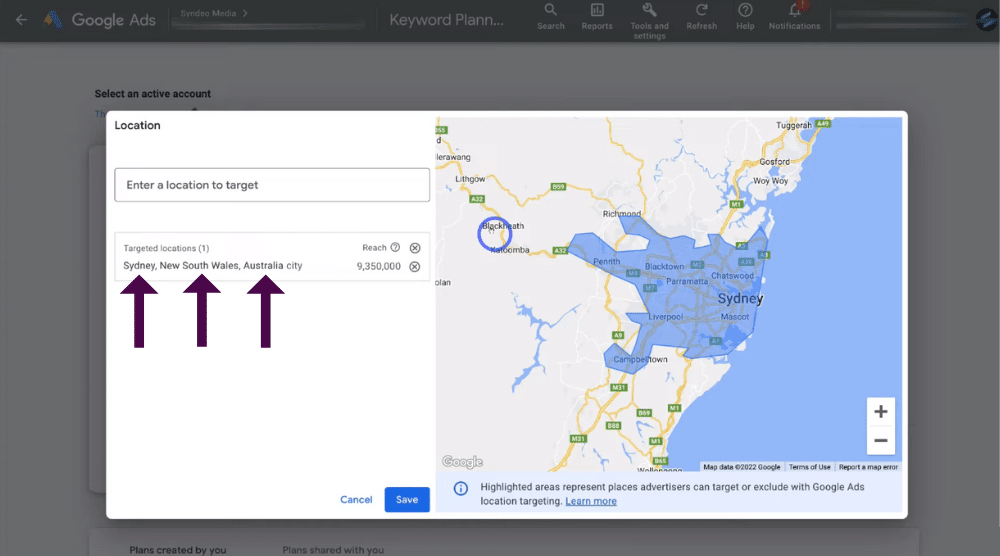
- Type in your country location in the search bar.
For us, we’re going to type in ‘Sydney, New South Wales, Australia’ (see screengrab).
Basically, if you operate in a geographical location, then you should be as specific as you can, meaning you should add the exact location that you operate in (including the city, state, and country).
- You’re also able to add other locations (if you target other locations, and you provide your products or services in those locations).
Once you’ve added this information in:
- Click ‘Save’.

- Navigate back up to the keyword search bar and add additional keywords if you like.
For the purpose of this how to do keyword research tutorial, we’re just going to add that one keyword in for now.
- Below your keyword search bar, you can additionally add a website URL to help filter unrelated keywords (see screengrab).
This URL would be say a competitor’s website, and aids with helping you identify more relevant keywords.
However, we’re not going to input any URLs.
Once you’re happy with your keywords and location:
- Click ‘Get results’.
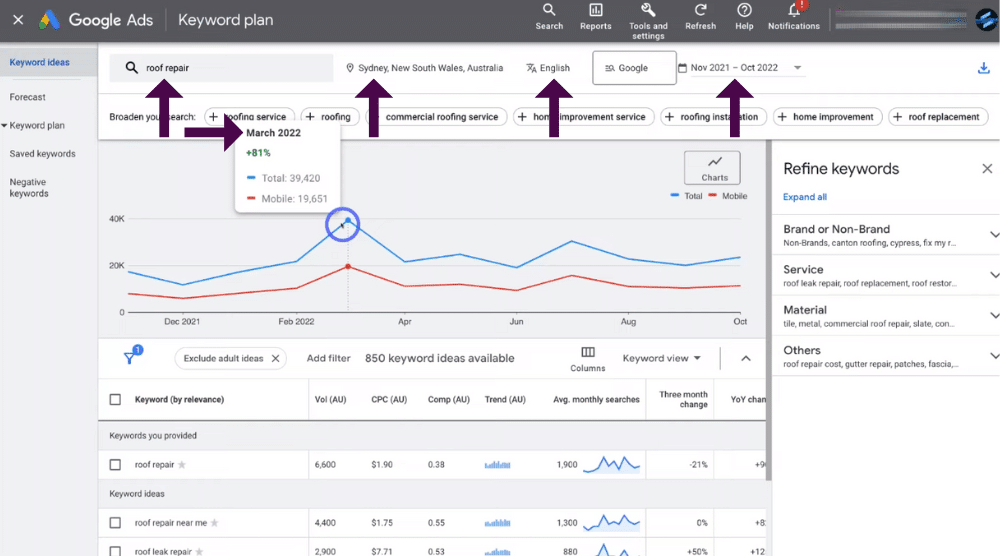
- This will take you to the Keyword planner.
- Within this free keyword planner tool, you’re able to view the initial keyword i.e ‘roof repair’ in the search bar that you added and that you want to target (see screengrab).
This is going to help you identify other keywords that are related to this keyword.
- Next to this, you’ll see the location you chose (the country and the region that you want to target).
- Then you have the language you want to target in.
- Below this, the keyword planner shows you additional keywords you can use to broaden your search (see screengrab).
These are other keywords that are related to the initial keyword that you’ve just entered.
However, we advise starting off with one keyword, then focusing on keywords that are specifically related to that target keyword.
Follow the steps below to navigate your way through the Keyword planner:
- You’ll notice a basic graph just below those additional keywords to broaden your search (that we just mentioned) (see screengrab).
This graph shows the total search volume per month for all the keywords related to the keyword that you entered.
So for our example, in March there was an 81% increase, total searches were 39,420 and 19,651 searches were mobile searches (see screengrab).
- Simply navigate through the past year to see the trend of keywords related to your keyword.
- Click ‘Date’ above the graph to change the date range if you’d like.
However, these current dates of November 2021 through to October 2022 (which is recent) give a recent overview of the search trend.

Next:
- Scroll down the page to see the other keywords that you provided earlier.
For our example, we have ‘Roof repair’ here, and below this are the keyword ideas relating to that keyword ‘Roof repair’ (see screengrab).
These are important keywords that you may not have added or thought about, but can be added to your list of target keywords!
Let’s take a look at one of our suggested keyword ideas as an example ‘Roof leak repair’ (see screengrab).
Now this keyword is a great keyword to target because of some key reasons:
- This keyword in Australia (all of Australia) has 2900 searches per month.
- The cost per click (how much advertisers are paying for targeting this keyword) is $7.71
- It has a moderate level of competition, being 0.53 (remember, this is between 0-1, with one being the highest level of competition)
- The average monthly search volume in the target location (which is Sydney) is 880 searches for the keyword ‘Roof leak repair’ per month.

Additionally:
- Scroll across and see the three monthly changes i.e 50% for each keyword idea (see screengrab).
- Next to this, you’re able to view the search volume and see if it has increased or not.
- You can then see the competition.
- Finally, you’re able to view the top of the page bid.
For this particular keyword idea example ‘Roof leak repair’, the search volume has increased, the competition is high and the top of the page bid is $2.67.
The ‘Top of the page bid’ means that if a roofing company is targeting that particular keyword ‘Roof leak repair’, then the lowest amount they have paid to reach the top of Google search (the first page of Google Search) is only $2.67.

Furthermore, this means this keyword is a keyword we want to target and add to our list of targeted keywords!
Again, the Keyword planner will suggest a bunch of different keyword ideas that you can add to your keyword target list.
Make sure you take the time and look at each keyword idea and check for a high search volume per month or low competition.
These are the keywords you want to be using.
Make sure that you are adding these targeted keywords throughout your content on the homepage of your website and other pages of your website.
So for us, we’re also going to add some of these suggested keyword ideas such as ‘Roofing contractor’ in our meta title and description, as well as in our title and description when using Google Ads.
Once you’ve added these suggested good keywords to your list:
- Repeat this process with different keywords that are related to your business, products or services.
Make sure you repeat this process until you have a strong list of keywords that you want to use online for your different marketing activities.
Again like we have already mentioned, if you’re currently not using Google Ads and you don’t want to pay for Google Ads, then don’t worry!
You can still use Google Ads and the Keyword Planner as a free keyword planner tool, however, you’ll have minimal information in terms of search volume, competition level and CPC information.
This information will all be limited.
Read more: How to use Keyword Planner.
5. Ubersuggest (Keyword Research Method Number 4)
Now let’s get stuck into our fourth and final tool!
This is a completely free keyword research tool called Ubersuggest, offered by Neil Patel.
To access this free keyword research tool:
- Simply head over to your browser.
- Type in app.neilpatel.com.

That’s going to take you here (see screengrab).
Next:
- Select ‘Keyword research’ over on the left-hand side bar.
- Click ‘Keyword overview’.
- Add a keyword in the search bar (see screengrab).
We’re going to continue with our roofing example for the purpose of this tutorial on how to do keyword research and add ‘Roof repair Sydney’ again as our keyword.
Once you’ve added in your keyword relevant to your business:
- Select the appropriate language under ‘Language’.
- Navigate over to ‘Location’ and select the correct location for your business.
We’re going to type in ‘Sydney’, as that’s where our audience is based and where we want to target.
- Click ‘Search’.
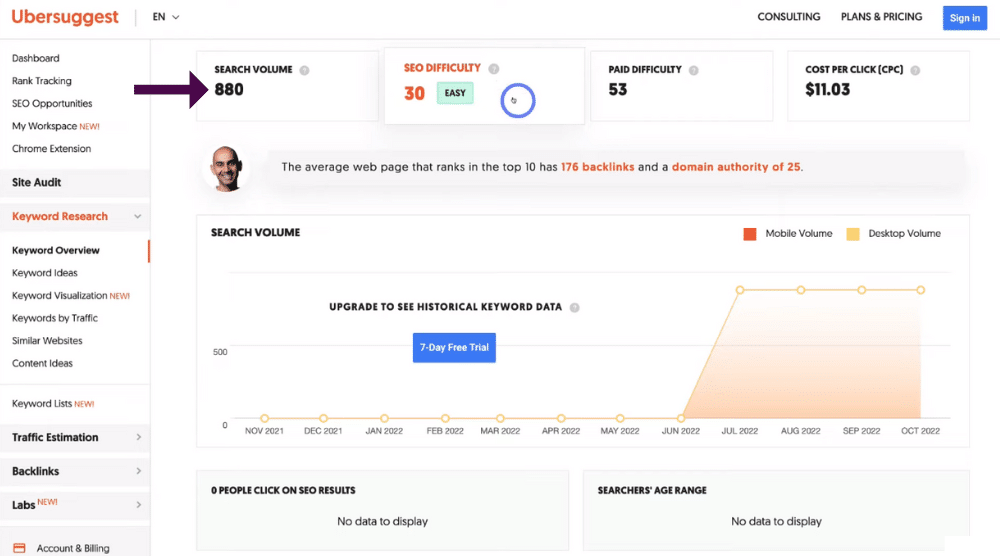
- Simply scroll down to ‘Keyword Overview’ to see the keyword overview for the keyword that you entered (see screengrab).
Remember, ours is ‘Roof repair Sydney’.
- Here you’ll see the ‘Search volume’.
Ours is 880, meaning there have been 880 searches for this keyword per month.
- Next to this you’ll see the ‘SEO difficulty’.
This essentially relates to how easy it is to rank on the first page of Google with this keyword.
In other words, if a potential customer searches for this keyword, how easy is it for you to rank at the top of Google search?
As you can see this particular keyword is easy, so we would want to target this keyword (see screengrab).
- Next to ‘SEO difficulty’, you can view the paid difficulty
- Finally, you’re able to see the CPC (cost per click).
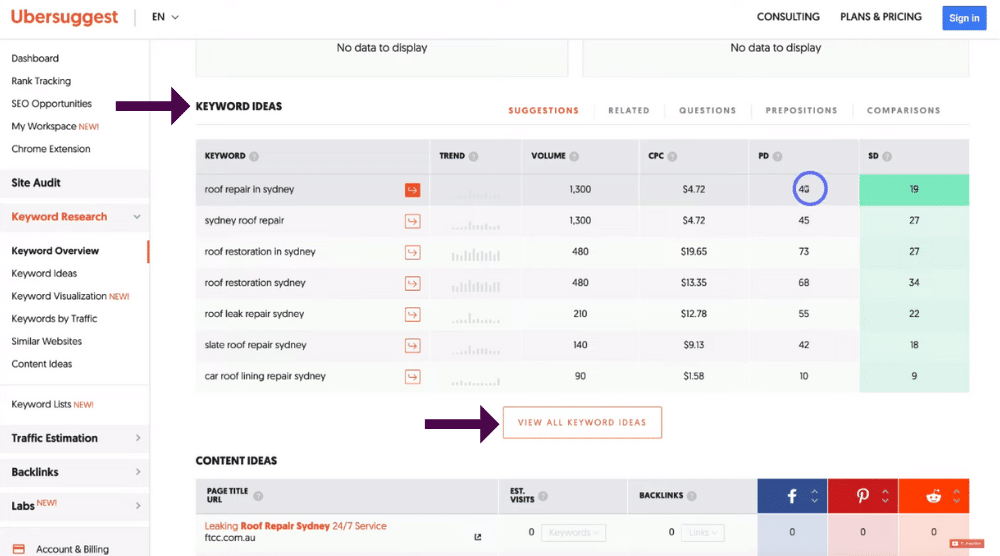
- Scroll down the page where you’ll find suggested relative keyword ideas (see screengrab)
This is similar to the other tools we’ve already mentioned.
Within each of these keyword ideas:
- Navigate over to find the trend, the volume of searches for this keyword per month, the CPC and the PD (paid difficulty) and SD (SEO difficulty) (see screengrab).
As you can see, all these keywords are highlighted green in the SD category (see screengrab).
This means that the SEO difficulty (for if we wanted to rank our website on Google search) is relatively easy to do so with these keywords!
Additionally:
- You can see the PD (paid difficulty).
This is if you wanted to use Google Ads to rank at the top of Google search.
If you want to view all keyword idea suggestions from this method:
- Simply click ‘View all keyword ideas’.
Now it’s important to note that there is actually a lot more you can do with each of these tools, such as:
- Navigating down to ‘Content ideas’ to view all content ideas (see screengrab).
That’s going to show you local competitors as well as the type of content that they’re creating, giving you ideas you can use to create blog posts using specific keyword search terms!
Again, with the other tools we talked about during this how to do keyword research guide, you can engage in more high-level and advanced keyword research.
However, this keyword research tutorial is just a beginner’s tutorial!
So we’re not going to delve into any advanced keyword research tools.
With that said, that concludes everything we wanted to cover in this keyword research tutorial!
Free SEO Keyword Research Tool – Video Guide
We have now shown you how to use four easy-to-use keyword research tools and methods to help you get started with keyword research and ultimately kick-start your business online!
You should now be able to confidently use and choose a variety of free or paid tools to ensure you are using the correct keywords to get discovered online, and rank higher on Google.
Additionally, you can check out the tutorial below for our full video guide on how to do keyword research using each of these keyword research tools.

